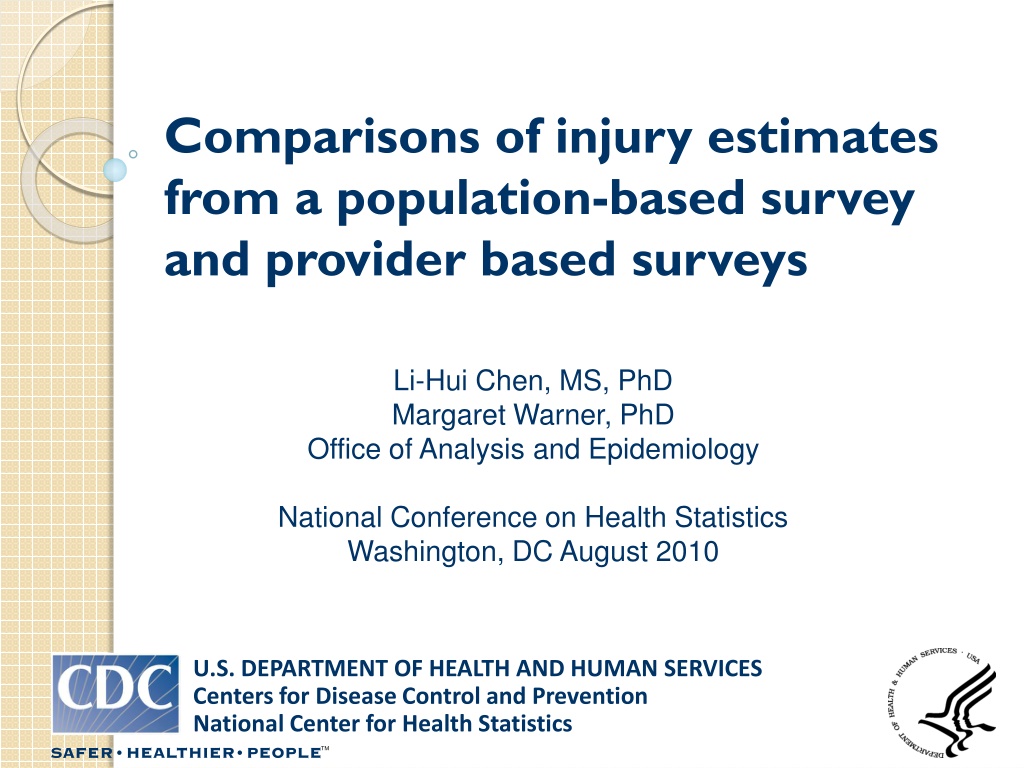A Comparison of Injury Estimates from Population-Based and Provider-Based Surveys
This study compares injury estimates obtained from a population-based health survey with estimates from two provider-based surveys. Data from the National Health Interview Survey (NHIS), National Hospital Ambulatory Medical Care Survey (NHAMCS-ED), and National Hospital Discharge Survey (NHDS) are analyzed to understand discrepancies in reporting injuries. The methods used in each survey to define and collect injury data are detailed to highlight variations in results.
Download Presentation

Please find below an Image/Link to download the presentation.
The content on the website is provided AS IS for your information and personal use only. It may not be sold, licensed, or shared on other websites without obtaining consent from the author. Download presentation by click this link. If you encounter any issues during the download, it is possible that the publisher has removed the file from their server.
E N D
Presentation Transcript
Comparisons of injury estimates from a population-based survey and provider based surveys Li-Hui Chen, MS, PhD Margaret Warner, PhD Office of Analysis and Epidemiology National Conference on Health Statistics Washington, DC August 2010 U.S. DEPARTMENT OF HEALTH AND HUMAN SERVICES Centers for Disease Control and Prevention National Center for Health Statistics
Objective To compare injury estimates from a population-based health survey with estimates from two provider-based surveys
Methods--Data Sources Three national surveys were used: Population-based survey National Health Interview Survey (NHIS): 2006-2008 Provider-based surveys National Hospital Ambulatory Medical Care Survey, Emergency Department component (NHAMCS-ED): 2007 National Hospital Discharge Survey (NHDS): 2007
Population-based survey: NHIS NHIS is a cross-sectional household interview survey of civilian non- institutionalized population. Data collected through personal interviews Respondents report information about injuries and Place of treatment
Provider-based Survey: NHAMCS-ED NHAMCS-ED is a national probability sample survey of visits to emergency departments of non-institutional general and short-stay hospitals. Data abstracted from medical records by trained hospital staff
Provider-based Survey: NHDS NHDS is a national probability sample survey of inpatient discharge records selected from non-Federal, short-stay hospitals. Data are collected by Manual review of medical records (55%), medical abstract form Automated system (45%), computerized data files containing machine-readable medical record data
Methods--Injury Definitions NHIS: Reported place of treatment for injuries was Emergency Department for injury ED visits or Hospital for injury hospital discharges NHAMCS-ED: initial ED visit Either a) a first-listed injury diagnosis code or b) a first-listed external cause of injury code (excluding adverse effects) NHDS: First-listed diagnosis code for injury
Methods--Rate calculation Denominators for rates: NHIS: US civilian non-institutionalized population, estimated from the sample. NHAMCS-ED and NHDS: US civilian population estimates provided by the Census Bureau.
Injury Treated in ED by Sex NHAMCS-ED and NHIS NHAMCS-ED NHIS-ED 120 100 Rate per 1,000 80 60 40 20 0 Male Female The estimated rate of injuries treated in the ED from NHIS was 63 per 1,000 population which is 0.7 times the estimate from NHAMCS-ED.
Injury Treated in ED by Age NHAMCS-ED and NHIS 160 The largest difference was among those aged 15-24. NHAMCS-ED 140 NHIS-ED 120 Rate per 1,000 100 80 60 40 20 0 Under 15 15-24 25-44 Age in years 45-64 65-74 75 and over
Injury Treated in Hospital by Sex NHDS and NHIS NHDS NHIS-Hosp 9 8 7 Rate per 1,000 6 5 4 3 2 1 0 Male Female The estimated rate for injuries treated in the hospital from NHIS was 8.3 per 1,000 population which is about 1.3 times the estimates from NHDS.
Injury Treated in Hospital by Age NHDS and NHIS NHDS NHIS-Hosp 50 45 40 Rates similar until age 75 Rate per 1,000 35 30 25 20 15 10 5 0 Under 15 15-24 25-44 45-64 65-74 75 and over Age in years
Differences between estimates Injury emergency department visit rates: NHIS estimates were 70% of the NHAMCS-ED estimates. Injury hospital discharge rates: NHIS estimates were 130% of the NHDS estimates.
Possible reasons for the differences in emergency department injury visit rates Injury episodes may not be reported in NHIS NHIS non-respondents may have higher ED injury rates than respondents. Injury incidence may be over estimated based on injury visits from NHAMCS-ED. Target population for NHAMCS-ED is difficult to determine. Different populations are covered by NHAMCS-ED and NHIS.
Possible reasons for the differences in injury hospital discharge rates Severe injuries are less likely to be forgotten during NHIS interview. NHDS includes non-federal, short-stay hospitals. NHIS response includes all hospitals. Injuries may be incorrectly classified as non-injury in the hospital discharge data based on medical records. Only first-listed injury diagnoses were included in injury hospital discharge rates in NHDS.
Strengths of NHIS The NHIS provides details not recorded on medical records which are useful for injury prevention and control. e.g. place of injury, activity when injured Detailed demographic information e.g. race/ethnicity, income, education Wide range of data available in one system e.g. functional limitation, heath behavior Linkable with other national data sets e.g. linked with mortality data through 2006
Conclusions For more severe injuries, such as those requiring hospitalization, the NHIS may provide higher estimates than medical records based surveys. For less severe injuries, such as those seen in the ED, the NHIS may underestimate the rate of injury. Rate differences could be due to issues in injury enumeration (e.g. misclassification, recall) and population coverage.
Questions? E-mail us at LChen3@cdc.gov or MWarner@CDC.GOV For more information on injury data and resources from NCHS, see: www.cdc.gov/nchs/injury.htm.























